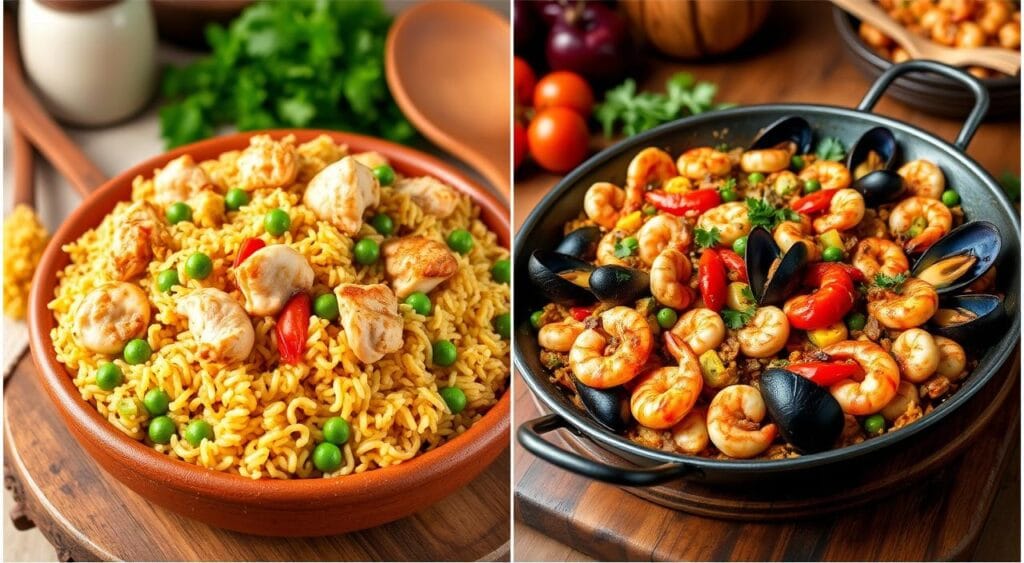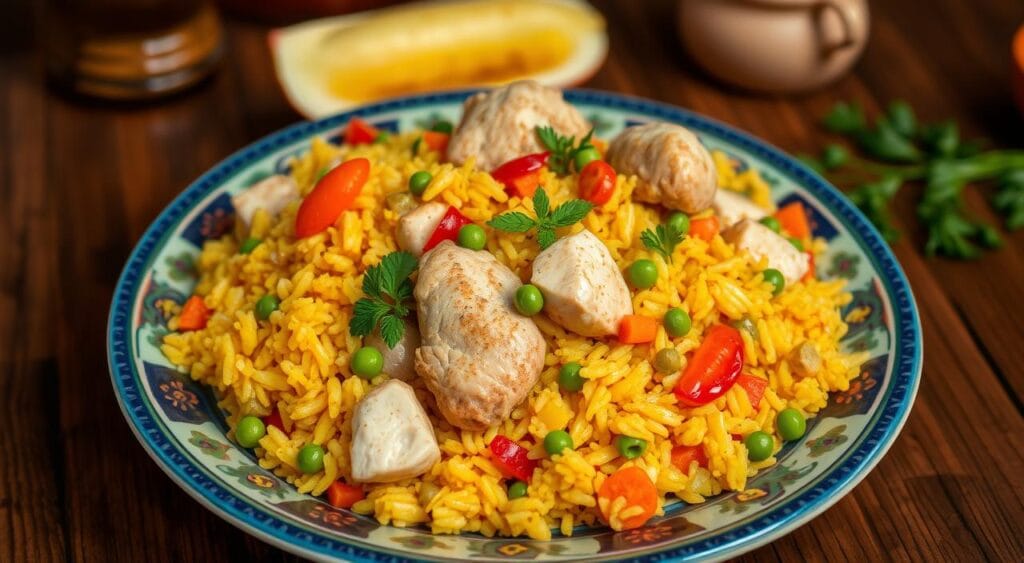Jump to:
Estimated reading time: 11 minutes
Table of contents
Arroz con pollo and paella are two famous dishes from Spain and Latin America. They both use rice, but they have different ingredients, cooking ways, and cultural values. Knowing how they differ helps us enjoy their rich history and varied tastes. First source:
Key Takeaways
- Arroz con pollo and paella are both rice-based dishes, but they originate from different cultural traditions.
- Paella is a Valencian specialty with a focus on seafood and saffron, while arroz con pollo is more common in Latin American cuisine and centers around chicken.
- The cooking methods and presentation styles of these two dishes vary significantly, with paella’s signature socarrat crust and arroz con pollo’s creamy texture.
- Both dishes offer unique regional variations, allowing for a diverse exploration of flavors and ingredients.
- Understanding the key differences between arroz con pollo and paella can enhance one’s appreciation for the richness of Spanish and Latin American culinary heritage.
Introduction
Arroz con pollo and paella are two beloved rice dishes. They have their own unique origins, ingredients, and cultural significance. This article will explore the key differences between these two iconic preparations.
Whether you’re a fan of Spanish cuisine or Latin American cuisine, this comparison will deepen your appreciation. It will highlight the nuances of these rice dishes and their cultural comparisons.
Paella, a quintessential dish of Spain’s Valencia region, is known for its vibrant saffron-infused rice. It also features mixed seafood and a complex flavor profile. Arroz con pollo, on the other hand, is a staple in Latin American cuisine. It features chicken and rice seasoned with aromatic spices and herbs.
As we delve into the origins and culinary traditions of these two iconic dishes, we’ll uncover the nuances that make them uniquely captivating.

This article will provide a comprehensive understanding of the differences between them. We’ll explore the selection of proteins and rice varieties. We’ll also look at the distinct cooking methods and presentation.
Join us as we embark on a flavorful journey. We’ll explore the cultural influences and regional variations that have shaped these beloved rice dishes.
Origins and Cultural Backgrounds of Arroz con Pollo and Paella
The origins of both of them show how agriculture and society changed in their areas. Paella started in Valencia, Spain, in the 15th century. It was made by farmers and workers with easy-to-find ingredients. On the other hand, arroz con pollo came from Spanish colonization in Latin America. The Spanish brought rice and cooking methods that locals adapted with their own ingredients.
History of Arroz con Pollo: Latin American and Spanish Roots
Arroz con pollo, or “rice with chicken,” has a long history. It started in Spain and went to Latin America, changing with local tastes. Now, each Latin American country has its own version of arroz con pollo, making it diverse.
The Story Behind Paella: A Valencian Classic
Paella’s history is tied to the Romans, Moors, and Arabic cuisine. It’s made in many ways, showing its flexibility. The Valencian paella, the original, includes rice, green veggies, rabbit, duck, snails, and spices.
How Their Cultural Significance Differs
Paella is about community and Spanish celebrations. Arroz con pollo, however, is a family comfort food in Latin America. Each dish reflects the traditions and tastes of its region.
“Arroz con Pollo is a traditional dish in Costa Rica that involves chicken and rice. The dish is flavored with Costa Rican spices, vegetables, and herbs, giving it a unique and unforgettable taste.”

Key Ingredients in Arroz con Pollo vs. Paella
The main differences between lie in their protein, rice, and spices. Arroz con pollo mainly has chicken, while paella includes chicken, rabbit, and seafood. Paella uses short-grain rice that soaks up liquids well. Arroz con pollo uses medium- or long-grain rice.
Protein Choices: Chicken vs. Mixed Seafood and Meat
Arroz con pollo focuses on chicken, often using bone-in pieces or boneless thighs. Paella, however, combines chicken, rabbit, and seafood like shrimp, mussels, and squid.
Types of Rice: Medium-Grain vs. Bomba Rice
The rice type greatly affects the dish’s texture and taste. Arroz con pollo uses medium- or long-grain rice, making it softer. Paella, with its short-grain Bomba or Calasparra rice, absorbs liquids well and forms a crispy bottom layer.
Spices and Seasonings: Sofrito and Saffron
Arroz con pollo’s flavor comes from garlic, cumin, paprika, and sofrito. Paella, however, is known for its saffron, which gives it a bright yellow color and a unique smell.
Cooking Methods: Preparing Arroz con Pollo and Paella
The way we cook both makes them unique. Paella needs a wide, shallow pan called a paellera. This helps cook the rice evenly and creates a tasty socarrat crust. On the other hand, arroz con pollo cooks in a single pot using simmering.
Cooking Vessels: Traditional Pots vs. Paella Pans
Paella cooks in a large, shallow pan called a paellera. This pan’s shape ensures the rice cooks well and gets the socarrat crust. In contrast, arroz con pollo cooks in a deep pot or Dutch oven, perfect for simmering.
Layering Techniques and Broth Usage
Paella has a special layering method. Seafood, chicken, and veggies are added in a certain order. Then, rice and broth are layered on top. Arroz con pollo is simpler, with chicken browned first, then rice and other ingredients.
Achieving the Desired Texture: Creamy vs. Socarrat
The cooking methods and vessels make each dish unique. Arroz con pollo is creamy and comforting. Paella, on the other hand, has a caramelized rice crust called socarrat at the bottom.
| Feature | Arroz con Pollo | Paella |
|---|---|---|
| Cooking Vessel | Deep pot or Dutch oven | Wide, shallow paellera pan |
| Layering Technique | Simpler, chicken browned first | Specific layering of ingredients |
| Texture | Creamy | Socarrat (caramelized rice crust) |
Flavor Profiles and Presentation Differences
Both are two famous rice dishes with unique tastes. The flavor profile of paella is rich and complex, with saffron, seafood, and meats blending together. It’s often served as a big dish, bringing people together.
Arroz con pollo has a cozy, simple taste that feels like home. Its flavors are savory and slightly spicy. It’s served as a family meal, easy to enjoy together.
Garnishes and Sides Vary
The garnishes and sides for paella and arroz con pollo show their cultural roots. Paella comes with lemon, aioli, or a green salad. Arroz con pollo might have beans, plantains, or avocado salad, adding extra flavors and textures.
The culinary traditions of Spain and Latin America shine through in these rice dishes. Their unique tastes and ways of serving highlight their cultural heritage.
“Paella is a symphony of flavors, while arroz con pollo is a comforting melody of home.”
Regional Variations of Arroz con Pollo and Paella
Both have many regional flavors. This shows the rich culinary diversity of Spain and Latin America. Paella comes in types like Paella Valenciana, Paella de Marisco (Seafood Paella), and Paella Mixta, each with its own protein mix.
Arroz con pollo also has its own special versions. For example, the Cuban version is richer and tomato-based. The Puerto Rican style is known for its sofrito seasoning. And the Colombian version adds extra vegetables for a heartier taste.
These differences come from local ingredients and cultural traditions. Each region has its own way of making these dishes.
Arroz con Pollo Across Latin America: Cuban, Puerto Rican, and Colombian Styles
The Cuban arroz con pollo has a deep tomato sauce. It often includes pimentos, green olives, and a hint of sweetness. On the other hand, the Puerto Rican arroz con pollo is famous for its aromatic sofrito seasoning.
The Colombian arroz con pollo is packed with vegetables like peas, carrots, and bell peppers. This makes it a vibrant and filling dish.
Paella Variations: Seafood, Mixed, and Valencian Paella
Paella comes in many forms, like the classic Paella Valenciana. It’s made with chicken, rabbit, and Valencian beans. Then there’s Paella de Marisco, filled with fresh seafood.
The Paella Mixta combines meat and seafood. This mix of flavors creates a unique taste experience. These variations show the creativity in Spanish cuisine.
How Regional Ingredients Influence Flavor
The flavors of both come from local ingredients. For example, saffron is key in paella. It gives a special aroma and color.
The sofrito base is vital for the smell of many Latin American arroz con pollo dishes. The type of rice, like Bomba in Valencian paella, affects the dish’s texture and taste.
FAQ: What Is the Difference Between Arroz con Pollo and Paella?
What is the main difference between Arroz con Pollo and Paella?
The main difference is that Arroz con Pollo is a simpler, chicken-and-rice dish commonly found in Latin America and Spain, while Paella is a traditional Spanish dish that often includes a variety of seafood, meats, and vegetables. Paella is also cooked in a wide, shallow pan and seasoned with saffron, which gives it a distinct yellow color and unique flavor.
Do Arroz con Pollo and Paella use different seasonings?
Yes, Paella is known for its use of saffron, which imparts a golden color and subtle flavor, while Arroz con Pollo typically uses spices like cumin, annatto, or turmeric in Latin American versions, giving it its own regional flavors.
Are the cooking methods for Arroz con Pollo and Paella different?
Yes, Paella is traditionally cooked in a special wide, shallow paella pan, which allows the rice to cook evenly and develop a crispy layer at the bottom called socarrat. Arroz con Pollo is typically cooked in a regular pot or skillet, without the focus on creating a crispy layer.
Which dish is more versatile in terms of ingredients?
Paella is generally more versatile, often including a mix of seafood, meats (like chicken, rabbit, or chorizo), and vegetables. Arroz con Pollo is primarily a chicken-and-rice dish, although some versions may include peas, bell peppers, or olives.
Is Paella or Arroz con Pollo more common in Latin America?
Arroz con Pollo is more commonly found in Latin America, with different variations across the region. Paella is originally from Spain, specifically the Valencia region, and is popular internationally but is less traditional in Latin American cuisine.
Additional Informations
Both are both Spanish rice dishes, but they differ. Arroz con pollo is simpler, with chicken and rice in one pan. Paella, on the other hand, is more complex, with seafood and meats.
The main differences between arroz con pollo and paella include:
- Protein Choice: Arroz con pollo uses chicken, while paella has seafood and meats like shrimp and mussels.
- Rice Type: Arroz con pollo uses white rice, but paella needs Bomba or Valencian rice for its texture.
- Cooking Vessel: Arroz con pollo is cooked in a pot, but paella needs a special pan.
- Cooking Method: Arroz con pollo cooks all ingredients together. Paella layers ingredients before cooking.
Arroz con pollo tastes homestyle, with sofrito and saffron. Paella has a richer flavor, mixing seafood, meat, and vegetables.
| Feature | Arroz con Pollo | Paella |
|---|---|---|
| Protein | Chicken | Seafood and Meat |
| Rice | Medium-Grain White | Short-Grain Bomba or Valencian |
| Cooking Vessel | Traditional Pot or Dutch Oven | Paella Pan |
| Cooking Method | One-Pot Dish | Layered Approach |
| Flavor Profile | Comforting, Homestyle | Complex, Nuanced |
Both arroz con pollo and paella are tasty Spanish rice dishes. They have their own flavors and traditions. Your choice depends on what you like and the occasion.
Conclusion: Appreciating the Unique Qualities of Both Dishes
Both arroz con pollo and paella are more than just food. They are key parts of their cultures, tied to family, community, and celebrations. Paella is a big deal in Spain, symbolizing joy and togetherness. Arroz con pollo, meanwhile, is a staple in Latin America, bringing warmth to family meals.
Paella comes from Valencia, Spain, and shows off Spanish cooking. It ranges from Paella Valenciana to Paella de Marisco, each telling a story of Spain’s food diversity. Using top-notch ingredients like Bomba rice and saffron is crucial for keeping its true taste alive.
Arroz con pollo, loved in Latin America, has its own special flavors and ways of cooking. From Cuba to Puerto Rico and Colombia, each version highlights the importance of family and tradition. By exploring the differences between arroz con pollo and paella, we gain a deeper respect for the world’s diverse food traditions.






